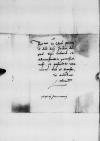Rediit servitor meus ex Cracow (Kraków, Cracovia), city in southern Poland, Małopolska, on the Vistula river, from 1038 capital of the Kingdom of Poland⌊CracoviaCracow (Kraków, Cracovia), city in southern Poland, Małopolska, on the Vistula river, from 1038 capital of the Kingdom of Poland⌋, quem mitto ad Reverendissimam Paternitatem Vestram, ut ea, quae vidit et audivit in aula Sigismund I Jagiellon (Zygmunt I) (*1467 – †1548), King of Poland and Grand Duke of Lithuania (1506-1548); Duke of Głogów (Glogau) (1499-1506), Duke of Opava (1501-1506), Governor of Silesia (1504-1506); son of King Kazimierz IV Jagiellon and Elisabeth of Austria
Sigismund II Augustus Jagiellon (Zygmunt II August) (*1520 – †1572), 1529-1572 Grand Duke of Lithuania (ruled from 1544); 1530-1572 King of Poland (crowned vivente rege (ruled from 1548, after the death of his father); son of Sigismund I Jagiellon and Bona Sforza⌊serenissimorum regumSigismund I Jagiellon (Zygmunt I) (*1467 – †1548), King of Poland and Grand Duke of Lithuania (1506-1548); Duke of Głogów (Glogau) (1499-1506), Duke of Opava (1501-1506), Governor of Silesia (1504-1506); son of King Kazimierz IV Jagiellon and Elisabeth of Austria
Sigismund II Augustus Jagiellon (Zygmunt II August) (*1520 – †1572), 1529-1572 Grand Duke of Lithuania (ruled from 1544); 1530-1572 King of Poland (crowned vivente rege (ruled from 1548, after the death of his father); son of Sigismund I Jagiellon and Bona Sforza⌋, coram narraret. Exiverant(?) serenissimi Sigismund I Jagiellon (Zygmunt I) (*1467 – †1548), King of Poland and Grand Duke of Lithuania (1506-1548); Duke of Głogów (Glogau) (1499-1506), Duke of Opava (1501-1506), Governor of Silesia (1504-1506); son of King Kazimierz IV Jagiellon and Elisabeth of Austria
Sigismund II Augustus Jagiellon (Zygmunt II August) (*1520 – †1572), 1529-1572 Grand Duke of Lithuania (ruled from 1544); 1530-1572 King of Poland (crowned vivente rege (ruled from 1548, after the death of his father); son of Sigismund I Jagiellon and Bona Sforza⌊principes nostriSigismund I Jagiellon (Zygmunt I) (*1467 – †1548), King of Poland and Grand Duke of Lithuania (1506-1548); Duke of Głogów (Glogau) (1499-1506), Duke of Opava (1501-1506), Governor of Silesia (1504-1506); son of King Kazimierz IV Jagiellon and Elisabeth of Austria
Sigismund II Augustus Jagiellon (Zygmunt II August) (*1520 – †1572), 1529-1572 Grand Duke of Lithuania (ruled from 1544); 1530-1572 King of Poland (crowned vivente rege (ruled from 1548, after the death of his father); son of Sigismund I Jagiellon and Bona Sforza⌋ ex Cracow (Kraków, Cracovia), city in southern Poland, Małopolska, on the Vistula river, from 1038 capital of the Kingdom of Poland⌊CracoviaCracow (Kraków, Cracovia), city in southern Poland, Małopolska, on the Vistula river, from 1038 capital of the Kingdom of Poland⌋ 6(?) Ianuarii et intraverunt Piotrków (Petricovia), city in central Poland, in the 15th-16th century the location of the assemblies of the Diet (Sejm) of the Kingdom of Poland, today Piotrków Trybunalski⌊PyotrkoviamPiotrków (Petricovia), city in central Poland, in the 15th-16th century the location of the assemblies of the Diet (Sejm) of the Kingdom of Poland, today Piotrków Trybunalski⌋ 11 eiusdem mensis simul et Bona Sforza (*1494 – †1557), Queen of Poland and Grand Duchess of Lithuania (1518-1557); the second wife of Sigismund I Jagiellon; Duchess of Bari and Rossano; daughter of Gian Galeazzo Sforza of Milan and Isabella of Aragon⌊reginalis maiestasBona Sforza (*1494 – †1557), Queen of Poland and Grand Duchess of Lithuania (1518-1557); the second wife of Sigismund I Jagiellon; Duchess of Bari and Rossano; daughter of Gian Galeazzo Sforza of Milan and Isabella of Aragon⌋. Propter dominos et amicos, qui mihi bene volunt, oportet me eo ocius ire Piotrków (Petricovia), city in central Poland, in the 15th-16th century the location of the assemblies of the Diet (Sejm) of the Kingdom of Poland, today Piotrków Trybunalski⌊PyotrkoviamPiotrków (Petricovia), city in central Poland, in the 15th-16th century the location of the assemblies of the Diet (Sejm) of the Kingdom of Poland, today Piotrków Trybunalski⌋ et iterum ad curiam Romanam mittere et expedire, quae sunt necessaria. Reverendissima Paternitas Vestra velit me diligenter commendare sacrae Sigismund I Jagiellon (Zygmunt I) (*1467 – †1548), King of Poland and Grand Duke of Lithuania (1506-1548); Duke of Głogów (Glogau) (1499-1506), Duke of Opava (1501-1506), Governor of Silesia (1504-1506); son of King Kazimierz IV Jagiellon and Elisabeth of Austria⌊maiestati regiaeSigismund I Jagiellon (Zygmunt I) (*1467 – †1548), King of Poland and Grand Duke of Lithuania (1506-1548); Duke of Głogów (Glogau) (1499-1506), Duke of Opava (1501-1506), Governor of Silesia (1504-1506); son of King Kazimierz IV Jagiellon and Elisabeth of Austria⌋ et hoc negotium meum, quomodo ego possem pacifice et quiete permanere in beneficiis meis, a longo tempore possessis, nec quicquam superesse video praeter unicam auctoritatem regiam domini mei clementissimi, accedente nihilominus gratia Reverendissimae Paternitatis Vestrae, in qua re maiestati regiae supplico, quatenus imprimis eius maiestas regali clementia uti beneficiorum meorum unicus collator adesse dignetur atque sanctissimo pro me scribere et intercedere, ut eidem Quirinus Galler (†1543), a merchant from Passau and the Fuggers' agent in Rome; scribe of the Roman Rota and notary of the Roman Curia (RC, No. 443, 479, 485; NOVA 1981, p. 355-372 )⌊Quirino GallerQuirinus Galler (†1543), a merchant from Passau and the Fuggers' agent in Rome; scribe of the Roman Rota and notary of the Roman Curia (RC, No. 443, 479, 485; NOVA 1981, p. 355-372 )⌋ principali meo adversario in Rome (Roma), city in central Italy, on the Tiber river, seat of the Holy See⌊UrbeRome (Roma), city in central Italy, on the Tiber river, seat of the Holy See⌋ silentium imponatur, ne me ad profunde ms. a(!)
⌈ee ms. a(!)
⌉ndum fortunas meas irritet. Cum his me et omnia mea iterum atque iterum commendo in gratiam Reverendissimae Paternitatis Vestrae, quam Jesus of Nazareth (Jesus Christ), in Christianity the Messiah foretold in the Old Testament⌊Christus IhesusJesus of Nazareth (Jesus Christ), in Christianity the Messiah foretold in the Old Testament⌋ servet diu sospitem et felicem pro singulari consolatione mea et domus meae.


 AAWO, AB, D.5, f. 128v
AAWO, AB, D.5, f. 128v